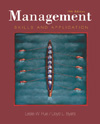Preface Since this book's inception ten editions ago, the field of management has evolved and changed in ways that could not have been anticipated. Through each revision we have attempted to keep pace with the times and adapt to these changes. In the fifth edition, for example, we introduced a skill-building approach that remains one of the book's hallmarks. In subsequent editions we have continued to add content and pedagogy that address shifts in the field of management. And always, we have worked to create a book that prepares students for a future in business. This edition continues that tradition. Relying on the suggestions of other professors, reviewers, students, and our own thoughts, we have attempted to retain the strongest parts of the previous editions and strengthen the weaker parts. As a result of the extensive input received, we have updated and revised some material, added new material, and eliminated some material. The effect of this work can be summarized by examining this edition more closely: New To This Edition of the Book - The Contemporary issues section has now been moved from section two to section six to allow for a more traditional flow of topics.
- Two-thirds of the "Management illustrations" throughout the text have been updated to highlight current corporate examples and management trends, while relating them to the topic at hand.
- Several new companies have been added to this edition such as Harley-Davidson and Igus Ink (a German company), along with updates of companies from the previous edition such as Saturn.
- The subject of diversity is now spread throughout the text as opposed to being concentrated in one chapter as in previous editions.
Structure of the Chapters The text's pedagogy has been revisited and revised as necessary to give readers the best tools to apply and understand the material presented. Look for these features in each chapter: - Learning Objectives--chapter-opening guidelines for students to use as they read. This list of key objectives provides the reader a roadmap for venturing into the text.
- Chapter Previews--real-life, up-to-date vignettes that illustrate one or more of the major points covered in the respective chapters. Preview analysis questions are presented at the end of each vignette to help the student relate the chapter material to the preview.
- Management Illustrations--brief, chapter-related corporate examples found in boxes throughout the chapters. These illustrations present more than 50 examples of concepts contained in the text, and more than 75% of them are new to this edition.
- Corporate/Organization References--more than 200 references to actual corporations and organizations. We are extremely proud of these references that best serve to bridge the gap between theory and practice. Look for them in the text itself, chapter previews, and management illustrations.
- Margin Glossary--key terms defined where mentioned in the text. This feature is especially helpful to students reviewing chapter material for study and/or testing.
- Review Questions--these questions, at the end of each chapter, tie directly back to the learning objectives. By tying the chapter concepts together from beginning to end, students can evaluate their understanding of key constructs and ideas.
- Skill-Building Questions--end-of-chapter questions designed to promote critical thinking. These questions ask students to get to a deeper level of understanding by applying, comparing, contrasting, evaluating, and illustrating ideas presented in the chapter.
- Skill-Building Exercises--end-of-chapter tools for students and instructors. These exercises can be assigned on the spot in class or as homework.
- Case Incidents--end-of-chapter short cases for students. These incidents present lifelike situations requiring management decisions related to the material covered in the respective chapters. As with the skill-building exercises, these can be assigned in class or as homework.
The Teaching Package A variety of support materials helps the instructor in teaching this dynamic field of management. These key items available with the tenth edition of the text are described below: NEW! We now provide an Online Learning Center for Management: Skills and Application. Visit this website at http://www.mhhe.com/rue10e to access a wealth of material both instructors and students. Make use of our links to professional resources, Internet exercises and assignments, skills modules, career corner, and flash cards to help review key terms. NEW! Manager's Hot Seat Videos. Watch real managers handle difficult situations in the workplace. These improvised tapes show you how issues like diversity, discrimination, telecommuting, and teams really shape the way business is done. Teaching notes provide background information and extensive teaching ideas. These videos are the perfect way to expose students to the interpersonal side of working in organizations. Lecture Resource Manual and Test Bank - The Lecture Resource Manual and Test Bank is the instructor's tool box for enhancing student learning. The manual contains brief chapter overviews; lecture outlines that include topical headings; definitional highlights; coordination points for key terms, review questions, and learning objectives: suggested answers to in-text questions; and transparency masters. The popular "Barriers to Student Understanding" feature addresses areas that are most often stumbling blocks for students. In this section, a series of suggestions guide the instructor in preparing for difficulties, covering easily misunderstood concepts, and aiding the student learning experience through directed discussion. The Test Bank section of the Lecture Resource Manual includes true-false, multiple choice, and essay questions is tied to the chapter learning objectives and classified according to the level of difficulty.
Brownstone Testing Software - This computerized testing software is available for users of both PCs and Macintosh computers. It provides instructors with simple ways to write tests that can be administered on paper, over a campus network, or over the Internet.
Power Point presentation software contains tables and graphs from the text as well as extra material. |



 2003 McGraw-Hill Higher Education
2003 McGraw-Hill Higher Education

 2003 McGraw-Hill Higher Education
2003 McGraw-Hill Higher Education